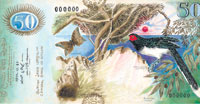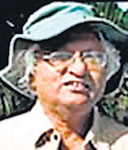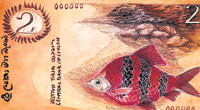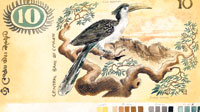- Were you always fascinated by numismatics- our coins and currency as works of art?
As long as I can remember my sketchbooks going back to the 1960s are strewn with design drawing ideas inspired by the fine incised and engraved design patterns on ancient pre-Christian coins. Even the Portuguese tangas and the Dutch guilders(V.O.C. stamped on the obverse side) have a fine sense of design.
Very few people realize that the ancient currency and coins of Sri Lanka are linked with the concept of trade- foreign and local - dating far back.The coinage would reflect the level of society from the period when Buddhism was introduced, centuries before the birth of Christ. The sophistication of the production and distribution of coinage found in our archaeological sites reflect the ability of the indigenous people in this country in skills in such disciplines as metallurgy and mathematics.
Because of the refined coinage our trading techniques were recognised for their sophistication, our ability to successfully interact commercially and communicate with foreign traders who plied the Indian Ocean trade route, the Arabs, Indians, Chinese, Persians, Phoenicians, Etruscans, Greeks, Romans and the great civilizations which have now long perished. Roman coins stamped with the insignia of a dozen or more Emperors of the pre-Christian era have been found in several coastal and inland archaeological sites. This was more than a thousand years before the arrival of European colonial powers, the Portuguese and Dutch.
- If all this is so, why does the Central Bank not heed your advice and look for a more productive use of their collection of fauna and flora currency issued in 1979 than merely disposing of it?
Very few officers in the Bank realize the significance of these notes. Some of our most able and talented minds in the fields of art, architecture, banking, commerce, and natural sciences pooled their resources to produce these notes.
In 1977, Bevis Bawa, the famous landscape designer of Brief, (his country residence in Bentota) and former ADC to the last three British Governors and brother of Geoffrey Bawa) was a close friend of one of the Directors of the firm of Bradbury Wilkinson who had won the contract to print the new currency notes. He immediately suggested that Laki Senanayake would be the ideal man for the task of submitting designs for these currency notes.
 |
Both Laki and I were frequent visitors to Brief and Lunuganga (Geoffrey Bawa’s now famous country retreat) as we were working for and within the architectural office of Edwards Reid and Begg of which Geoffery Bawa was one of the senior partners.Laki had conceptualised what the whole series would be and I suggested that he use the resources in my library which had a fine collection of Natural History images of the nineteenth century – the golden age of the production of fine quality hand printed natural history images, plates which used sophisticated techniques of reproduction –with coloured engravings in varied mediums like wood engraving, copper engraving, aquatints and lithography.
Bennet’s Fishes of Ceylon (1845), Legge’s Birds (3 parts-1880), Trimen’s Flora of Ceylon (5 volumes 1898-1908), Moore’s Lepidoptera (6 Volumes-1880), Henry’s Colour Plates of the Birds of Ceylon (4 Volumes 1928-30) were some of the sources for the designs that appear as images on the Fauna and Flora currency notes.
Laki used to spend whole days and nights working at my residence in Colonel T.G. Jayawardene Mawatha in Kollupitiya, Colmbo. His patience was tested by my daughter who was then two years old and who would remix the pigments which were carefully set up by Laki over hours of testing and matching of colours- only to find he had to start all over again. This probably inspired my daughter to become an accomplished natural history artist herself!
These colour illustrations and descriptive texts were used for re-designing, re-drawing and setting out these fine specimens as images on a coloured backdrop of Sri Lanka’s rich wildlife- endemic and unique flora and fauna set in the correct ecological niche. Laki did as many as 200 fully finished paintings and sketches. He was invited to the printing workshops of Bradbury Wikinson where the designs were re-organised to fit into a sophisticated, ultra-modern, cutting-edge printing technique available to reproduce these images in the production of currency notes.
 |
| Ismeth Raheem |
Herbert Tennekoon( if my memory is not faulty) was the then Governor of the Central Bank who totally approved of the design. Our architectural office was then involved in designing the Board Room of the Bank in the topmost floor and some of these designs spilled over and were used for the wall hangings designed by Ena de Silva.The rest is all history now contained and published in numerous books the world over. These images have appeared on paper, ceramic tiles, cloth, and metal. The International Currency Collectors Manual even thought it fit to put the 50 Rupees of the Fauna and Flora series on its cover.
The most comprehensive book on the Sinharaja Rainforest published in 1986 had the Green Billed Coucal on its cover reproduced from one of the many designs done for the initial selection for the printing of the currency notes. The publication was funded by the Smithsonian Institute, Washington and New York Zoological Society. ‘Bevis Bawa’ (Thames and Hudson 1995) also covers Laki’s notes.
The Paris Metro (without obtaining copyright approval) reproduced them in a busy underground railway station. The March for Conservation, an NGO backed by the Smithsonian and New York Wild Life Fund had some of these currency images on their promotional t shirts.
In the light of all this I believe that the Governor and the Board of the Central Bank will safeguard our heritage and not dispose of these valuable historic documentation -which many institutions, private and state will love to get their hands on. I have myself written to the Central Bank and received an assurance and positive response- but between cup and lip, there might be one who gives us the slip...
| 



